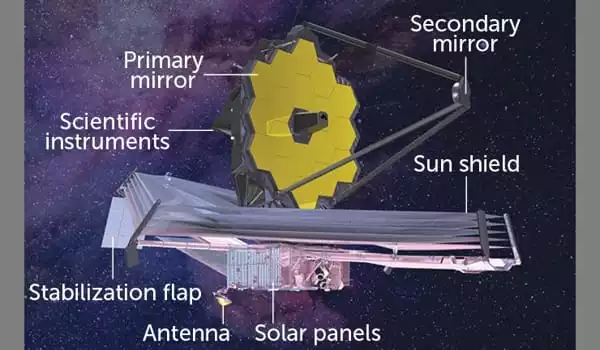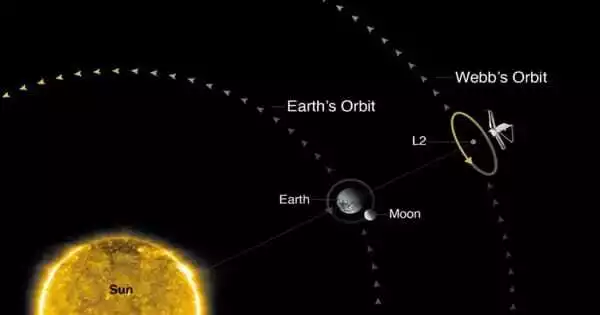The James Webb Space Telescope, often known as Webb or JWST, is a massive space-based observatory tuned for infrared wavelengths that will complement and extend Hubble Space Telescope discoveries. It will have greater sensitivity and will cover longer wavelengths of light than Hubble. JWST can now go further back in time to observe the earliest galaxies that formed in the early universe, as well as peer inside dust clouds where stars and planetary systems are developing today, thanks to the longer wavelengths.
The optics and scientific instruments of the James Webb Space Telescope must be cool to decrease infrared background “noise” because it is an extraordinarily sensitive infrared astronomical observatory. Furthermore, the detectors inside each scientific equipment, which transform infrared light impulses into electrical signals for processing into images, must be cool in order to function properly. In general, the longer the wavelength of infrared light, the colder the detector must be to do this conversion while limiting the creation of random “noise” electrons.
Before it can begin watching the universe, the observatory’s MIRI instrument must cool close to absolute zero, the temperature at which atomic motion ceases. As it prepares to snap its first scientific photographs of the distant universe this summer, the James Webb Space Telescope continues to cool down. One instrument in particular need assistance to do the task.
Webb’s infrared sensitivity allows us to understand what happens at these very first stages, as gas and dust are actively collapsing to form new stars.
Klaus Pontoppidan
The James Webb Space Telescope is sitting at Lagrange Point 2, some 930,000 miles (1.5 million kilometers) from Earth, buried behind the planet and a massive sunshield. The expedition was meticulously planned to preserve the telescope’s mirrors and instruments at an extraordinarily low temperature of minus 369.4 degrees Fahrenheit at all times (minus 223 degrees Celsius). This is significant since Webb observes the universe in the electromagnetic spectrum’s warmth-carrying infrared wavelengths, and any heat from the telescope itself would dazzle its detectors.
For the telescope’s Mid-InfraRed Instrument (MIRI), however, even that temperature is not cold enough. The instrument’s detectors require an even colder temperature of minus 447 degrees F (minus 266 degrees C), only 12 degrees F (7 degrees C) above absolute zero, the temperature where motion of atoms stops.

As a result, Webb has a cryocooler to assist MIRI in cooling down. According to NASA in a statement(opens in new tab), the cryocooler is essentially a “sophisticated refrigerator” that actively cools MIRI. The refrigerant is cooled by conduction in a set of tubes before being pushed through the instrument to keep it cold. Because the cryocooler does not use coolant, it can run for the whole life of its technical components.
Once operational, MIRI will be able to detect the light of the most distant stars in the universe but also peer through dust clouds within our galaxy, the Milky Way, to witness how stars form.
“Webb’s infrared sensitivity allows us to understand what happens at these very first stages, as gas and dust are actively collapsing to form new stars,” Klaus Pontoppidan, the Space Telescope Science Institute project scientist for Webb, said in the statement.
Three of Webb’s four scientific tools are capable of “seeing” both the reddest visible light and near-infrared light (light with wavelengths from 0.6 microns to 5 microns). These instruments have detectors made of Mercury-Cadium-Telluride (HgCdTe), which works best for Webb at 37 degrees Celsius. We can achieve this temperature in space “passively” because to Webb’s design, which features a tennis court-sized sunshield.
The Mid-infrared Instrument, or MIRI, on the other hand, “sees” mid-infrared (MIR) light at wavelengths ranging from 5 to 28 microns. MIRI’s detectors, by necessity, are a different formulation (Arsenic-doped Silicon (Si:As)), which requires a temperature of less than 7 kelvin to function properly. Because this temperature cannot be achieved on Webb through passive means alone, Webb contains a “cryocooler” specialized to chilling MIRI’s detectors.
Because the cryocooler is a refrigerator and a “closed” system, it does not consume coolant like an ice chest full of ice or a large container (a.k.a. dewar) of liquid helium, so its life is limited only by wear in its moving parts (the pumps) or the longevity of its electronics, all of which should last for many years.





